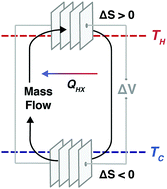当前位置:
X-MOL 学术
›
Energy Environ. Sci.
›
论文详情
Our official English website, www.x-mol.net, welcomes your
feedback! (Note: you will need to create a separate account there.)
Continuous electrochemical heat engines†
Energy & Environmental Science ( IF 32.4 ) Pub Date : 2018-07-16 00:00:00 , DOI: 10.1039/c8ee01137k Andrey D. Poletayev 1, 2, 3, 4, 5 , Ian S. McKay 2, 3, 4, 6 , William C. Chueh 1, 2, 3, 4, 5 , Arun Majumdar 2, 3, 4, 7, 8
Energy & Environmental Science ( IF 32.4 ) Pub Date : 2018-07-16 00:00:00 , DOI: 10.1039/c8ee01137k Andrey D. Poletayev 1, 2, 3, 4, 5 , Ian S. McKay 2, 3, 4, 6 , William C. Chueh 1, 2, 3, 4, 5 , Arun Majumdar 2, 3, 4, 7, 8
Affiliation

|
Given the large magnitude of energy in waste heat, its efficient conversion to electrical power offers a significant opportunity to lower greenhouse gas emissions. However, it has been difficult to optimize the performance of new direct energy conversion approaches because of the coupling between entropy change and thermal and electrical transport in continuously operating devices. With electrochemical cells driving flowing electrolytes in symmetric redox reactions at different temperatures, we demonstrate two continuous electrochemical heat engines that operate at 10–50 °C and at 500–900 °C, respectively. Simulations of kilowatt-scale systems using electrochemical cells stacked in series suggest efficiencies over 30% of the Carnot limit and areal power densities competitive with solid-state thermoelectrics at maximum power. Although entropy change, thermal transport and electrical transport are inherently coupled in solid-state thermoelectrics, they can be somewhat circumvented in electrochemical systems, thus offering new opportunities to engineer efficient energy conversion systems.
中文翻译:

连续电化学热机†
鉴于废热中的能源数量巨大,其有效转化为电能提供了减少温室气体排放的重要机会。然而,由于熵变化与连续操作装置中的热和电传输之间的耦合,因此难以优化新的直接能量转换方法的性能。在不同温度下,电化学电池在对称的氧化还原反应中驱动流动的电解质,我们展示了两个连续的电化学热机,分别在10–50°C和500–900°C下运行。使用串联堆叠的电化学电池进行的千瓦级系统的仿真表明,效率超过了卡诺极限的30%,并且单位面积功率密度在最大功率下可与固态热电竞争。
更新日期:2018-07-16
中文翻译:

连续电化学热机†
鉴于废热中的能源数量巨大,其有效转化为电能提供了减少温室气体排放的重要机会。然而,由于熵变化与连续操作装置中的热和电传输之间的耦合,因此难以优化新的直接能量转换方法的性能。在不同温度下,电化学电池在对称的氧化还原反应中驱动流动的电解质,我们展示了两个连续的电化学热机,分别在10–50°C和500–900°C下运行。使用串联堆叠的电化学电池进行的千瓦级系统的仿真表明,效率超过了卡诺极限的30%,并且单位面积功率密度在最大功率下可与固态热电竞争。











































 京公网安备 11010802027423号
京公网安备 11010802027423号